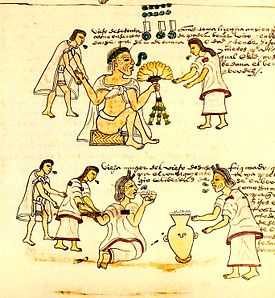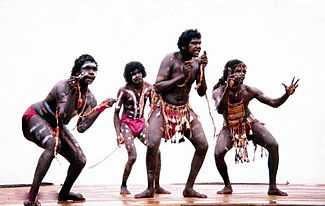Loincloth

A loincloth is a one-piece garment – sometimes kept in place by a belt – which covers the genitals and, at least partially, the buttocks.
History and types
Loincloths are being and have been worn:
- in societies where no other clothing is needed or wanted
- as an undergarment or swimsuit
- by the Wrestlers and farmers in paddy fields in Sri Lanka and India, it is called Kaupinam or Langot
The loincloth, or breechcloth, is a basic form of dress, often worn as an only garment. Men have worn a loincloth as a fundamental piece of clothing which covers their genitals – not the buttocks – in most societies which disapproved of genital nakedness throughout human history. The loincloth is in essence a piece of material, bark-bast, leather, or cloth, passed between the legs and covering the genitals. Despite its functional simplicity, the loincloth comes in many different forms.

A breechcloth, or breechclout, consists of a strip of material – bark, cloth, leather – passed between the thighs and secured by a belt. A loincloth is a long piece of cloth, passed between the thighs and wound around the waist in one of many fashions to cover the genitals with decency. Breechcloths and loincloths are garments of dignity among those who traditionally wear them. The styles in which breechcloths and loincloths can be arranged are myriad. Both the Bornean sirat and the Indian dhoti have fabric pass between the legs to support a man's genitals.
A particular style of loincloth (more typical of tropic regions) consists of a single long strip of bark-cloth or woven cloth. This was used by the inhtabitants of the Austronesian speaking area of Southeast Asia and Oceania, where it was known as chawat [cawat], sirat, bah, bahag, maro or malo. The cawat/maro style loincloth is an important cultural marker of the region.
Various cultures in tropical Africa wore or still wear loincloths, often as (nearly) the only traditional garment for every day use. The loincloth of Southern African San, called !xai, is a piece of skin roughly T-shaped with long ties at the corners of the arms. The free end is pulled in back and tucked under the ties.
The ancient Egyptians, both men and women, wore loincloths as underwear, the men beneath their kilt-like schenti. These loincloths consisted of fine linen cloths in a triangular shape with ties at the two corners. The base of the triangle was placed at the small of the back and the ties tied in front, then the point or apex was drawn between the legs and tucked under the string, exactly the opposite of the San fashion.
A similar style of loincloth was also characteristic of ancient Meso-America. The male inhabitants of the area of modern Mexico wore a wound loincloth of woven fabric. One end of the loincloth was held up, the remainder passed between the thighs, wound about the waist, and secured in back by tucking.[1]

In Pre-Columbian South America, ancient Inca men wore a strip of cloth between their legs held up by strings or tape as a belt. The cloth was secured to the tapes at the back and the front portion hung in front as an apron, always well ornamented. The same garment, mostly in plain cotton but whose aprons are now, like T-shirts, sometimes decorated with logos, is known in Japan as etchu fundoshi.
Some of the culturally diverse Amazonian Indians still wear an ancestral type of loincloth.
In most of (sub-)tropical continental Asia, types of loincloth such as the Indian lungi, often unisex or with a close female counterpart, remain in use as traditional dress, especially among the rural peasant communities, while city dwellers tend to adopt western style costumes. An elaborate, decorated form is also worn as the only garment in certain martial arts, such as Kerala's Kalaripayattu; like the aptly named boxer shorts, it must allow the fighters free, even acrobatic movement.
Japanese men traditionally wear (formerly always) a loincloth known as a fundoshi. The fundoshi is a 35 cm (14 inch) wide piece of fabric (cotton or silk) passed between the thighs and secured to cover the genitals.
Men of Indo-European culture, Greeks, Romans and Scandinavians, wore the loincloth more or less habitually. (Women wore a fuller version, with ties before and behind, "bikinis" called a "perizoma", as depicted on the mosaics at Piazza Armerina.) An ancient version of the loincloth, the breechcloth, was found in the Alps on a ca. 3200 BCE archaeological find named Ötzi.
After the fall of the Roman empire, the loincloth disappeared in Europe. Trousers of one kind or another, which had been considered a Celtic oddity in the Ancient Mediterranean cultures, became the usual wear for men.
Connotations
When Westerners once again came into contact with loincloths elsewhere, they viewed it as an exotic and indecent garment, because the wearer's buttocks were exposed. The connection of loincloth-wearing with "backwardness" became even more pronounced in the 19th century heyday of colonialism and industrialisation. Often the only garment black male slaves in tropical colonies were permitted to wear was a scanty breechcloth, while even the working class in the West wore at least a shirt and trousers.
During the Second World War, Allied prisoners of war in the harsh Japanese camps often had nothing but a breechcloth (etchu fundoshi) to wear.
At present the loincloth is nearly extinct as normal male wear in the industrialized world, except in certain contexts in Japan. However, in some cases it is worn as part of tribal - or national dress, either for the benefit of tourists, by tradition or as a statement. It is occasionally worn in jest by naturists on the village square and near the port of the naturist village Ile du Levant, where by law some cloth must be worn.
Breechcloth

A breechcloth, or breechclout, is a form of loincloth consisting in a strip of material – usually a narrow rectangle – passed between the thighs and held up in front and behind by a belt or string.[2][3] Often, the flaps hang down in front and back.[3]
Native Americans
In most Native American tribes, men used to wear some form of breechcloth, often with leggings.[3][4][5][6] The style differed from tribe to tribe. In many tribes, the flaps hung down in front and back; in others, the breechcloth looped outside the belt and was tucked into the inside, for a more fitted look.[3] Sometimes the breechcloth was much shorter and a decorated apron panel was attached in front and behind.[3]
A Native American woman or teenage girl might also wear a fitted breechcloth underneath her skirt, but not as outerwear. However, in many tribes young girls did wear breechcloths like the boys until they became old enough for skirts and dresses.[3] Among the Mohave people of the Southwest, a breechcloth given to a young female symbolically recognizes her status as hwame.[7]
Japanese and Europeans
Some European men around 2000 B.C. wore leather breechcloths, as can be seen from the clothing of Ötzi.[8]
During World War II, Allied prisoners of war in Japanese camps often had nothing but a textile breechcloth to wear, affording them only a modicum of modesty and free transpiration, but virtually no protection against the tropical sun, parasites, etc.
Japanese men traditionally wore a breechcloth known as a fundoshi. The fundoshi is a 35 cm (14 inch) wide piece of fabric (cotton or silk) passed between the thighs and secured to cover the genitals. There are a hundred ways of tying the fundoshi,[9] and in the modern age, men are coming to enjoy using patterned cloth for their fundoshis.
See also
- Perizoma (loincloth)
- Fundoshi
- G-string
- Kowpeenam
- Sarong
References
Notes
- ↑ Local names: Nahuatl maxtlatl, Mayan ex.
- ↑ U.S. National Park Service. Retrieved on 2009-12-22.
- ↑ 3.0 3.1 3.2 3.3 3.4 3.5 Native Languages. Retrieved on 2009-12-22.
- ↑ Minor, Marz & Minor, Nono (1977). The American Indian Craft Book. Bison Books. pp. 72-73. ISBN 0-8032-5891-7. Google Book Search. Retrieved on 2010-07-15.
- ↑ Mayfield, Thomas Jefferson (1997). Adopted by Indians: A True Story. Heyday Books. p. 83. ISBN 0-930588-93-2. Google Book Search. Retrieved on 2010-07-15.
- ↑ Typical Indian Clothing (male). Retrieved on 2010-07-15.
- ↑ Conner, Sparks, and Sparks, eds. (1997) Cassell's Encyclopedia of Queer Myth, Symbol, and Spirit: Covering Gay, Lesbian, Bisexual, and Transgender Lore
- ↑ South Tyrol Museum of Archaeology. Retrieved 2010-07-15.
- ↑ Fundoshi
External links
| Wikimedia Commons has media related to Loincloths. |
- The Loincloth of Borneo
- Breechcloth on Wordnik, retrieved on 22.12.2009
- Breechcloth by Rick Obermeyer (Dec. 1990), retrieved on 22.12.2009
| ||||||||||||||||||||||||||
| ||||||||||||||||||||||||||||||||||||||||||||||||||||||||||||||||||||